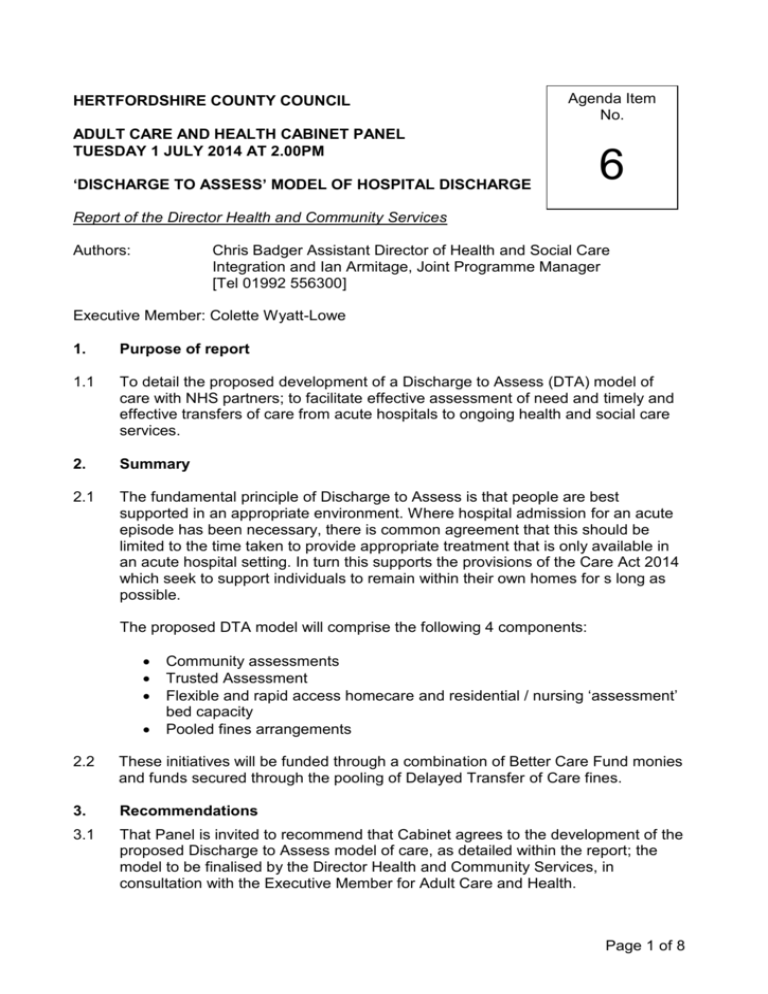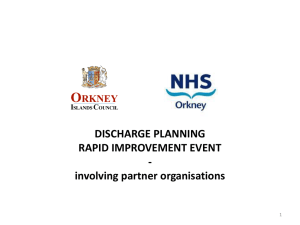DRAFT PROFROMA - Hertfordshire County Council
advertisement

HERTFORDSHIRE COUNTY COUNCIL Agenda Item No. ADULT CARE AND HEALTH CABINET PANEL TUESDAY 1 JULY 2014 AT 2.00PM ‘DISCHARGE TO ASSESS’ MODEL OF HOSPITAL DISCHARGE 6 Report of the Director Health and Community Services Authors: Chris Badger Assistant Director of Health and Social Care Integration and Ian Armitage, Joint Programme Manager [Tel 01992 556300] Executive Member: Colette Wyatt-Lowe 1. Purpose of report 1.1 To detail the proposed development of a Discharge to Assess (DTA) model of care with NHS partners; to facilitate effective assessment of need and timely and effective transfers of care from acute hospitals to ongoing health and social care services. 2. Summary 2.1 The fundamental principle of Discharge to Assess is that people are best supported in an appropriate environment. Where hospital admission for an acute episode has been necessary, there is common agreement that this should be limited to the time taken to provide appropriate treatment that is only available in an acute hospital setting. In turn this supports the provisions of the Care Act 2014 which seek to support individuals to remain within their own homes for s long as possible. The proposed DTA model will comprise the following 4 components: Community assessments Trusted Assessment Flexible and rapid access homecare and residential / nursing ‘assessment’ bed capacity Pooled fines arrangements 2.2 These initiatives will be funded through a combination of Better Care Fund monies and funds secured through the pooling of Delayed Transfer of Care fines. 3. Recommendations 3.1 That Panel is invited to recommend that Cabinet agrees to the development of the proposed Discharge to Assess model of care, as detailed within the report; the model to be finalised by the Director Health and Community Services, in consultation with the Executive Member for Adult Care and Health. Page 1 of 8 4. Background The Health and Social Care Act 2012 contains a number of provisions to encourage and enable the NHS, local government and other sectors, to improve patient outcomes through far more effective co-ordinated working : The creation of Clinical Commissioning Groups The obligation on Health and Well Being Boards to encourage health and care commissioners to work together to advance the health and wellbeing of the people in its area In addition, Section 3 of the Care Act 2014 which was given Royal Assent on 14 May 2015 places a duty on local authorities to carry out their care and support responsibilities (including carer’s support and prevention services) with the aim of joining-up services with those provided by the NHS and other health-related services The duty applies where the local authority considers that integration of services would (a) promote the well-being of adults in its area with needs for care and support and the well-being of carers in its area, (b) contribute to the prevention or delay of the development by adults in its area of needs for care and support or the development by carers in its area of needs for support, or (c) improve the quality of care and support for adults, and of support for carers, provided in its area (including the outcomes that are achieved from such provision). This reflects the similar duty placed on clinical commissioning groups by Section 14Z1 of the National Health Service Act 2006. In turn, the continuous integration of health and social care is an objective of the recently agreed Better Care Fund.1 It is also an ambition of Hertfordshire's Health and Wellbeing Board. 4.1 1 The Council has committed to pooling £120m of social care monies with NHS monies, to create a joint Better Care Fund budget of approximately £240m. The monies within this budget, nearly all of which is money already invested in the health and social care system, will be used to jointly commission a range of services for older people The Better Care Fund Background Paper and Plan is available on HertsDirect Page 2 of 8 4.2 The Better Care Fund, and its associated “metrics” focuses strongly on integration between primary care, acute services and social care as a means of preventing admission to acute care, but also as a means of facilitating timely discharge to increase patient flow within acute hospitals, and effective enablement post-acute care. Critically, the national conditions of the Better Care Fund include the following conditions and metrics which are especially pertinent to discharges and assessment: • • • • ‘7 day working’ in health and social care Better data sharing between NHS and social care Joint assessment and ‘accountable professionals’ Protection of social care services (not spending) Similarly, the national metrics include: • Delayed transfers of care • Avoidable emergency admissions • Effectiveness of re-ablement 4.3 Historically, national policy around transfers of care between acute trusts and local authorities as the providers of social care has been governed under a fines system, implemented through the Community Care (Delayed Discharges etc. Act 2003). Under this system councils are fined on a per day basis for those patients who are medically fit to be discharged from hospital but whose discharge is delayed due to the appropriate social care assessment not being undertaken, or because suitable social care provision is not available at that time. This reimbursement currently has no direct benefit to patients, whereas the Discharge to Assess scheme will be utilised to provide direct services. The daily fine is £120 for a hospital in the London area, and £100 for non-London areas. In light of the steps already taken to integrate provision and pool resources by the Local Authority, CCG’s (Clinical Commissioning Groups) and the Acute Trusts in relation to provision for older people, a fines system no longer appears to be an optimal process to be used to improve patient outcomes. 4.4 Delayed transfers of care have reduced significantly in recent years, as the table below indicates. Year 2010 - 2011 2011 - 2012 2012 - 2013 2013 - 2014 4.5 Annual fines 819,058.00 567,168.00 447,268.00 500,480.00 Approximate days of delay 7445 5156 4066 4550 Discharge to Assess 4.5.1 Health and social care systems are increasingly beginning to implement Discharge to Assess models of care. The fundamental principle of Discharge to Assess is that people are best supported in an appropriate environment. Where hospital admission has been necessary, there is common agreement that this should be limited to the time taken to provide appropriate treatment that is only available in an acute hospital setting. Page 3 of 8 4.5.2 Any stay beyond the point of a patient benefitting from their admission (and in certain cases where their recovery would be more beneficially achieved in a nonacute placement) introduces risks of hospital acquired infection, increase in confusional state, potential loss of mobility and physical function, and psychological deterioration, termed ‘decompensation’. In turn, this can lead to an increased reliance on on-going social care packages.2 4.5.3 In order to ensure a person receives the right level of support once they have ceased to benefit from their admission it is essential (and a statutory obligation for health and social care authorities) that an appropriate assessment of need is provided. Discharge to Assess works on the premise that once a patient has achieved their optimum benefit from being in hospital, they are discharged to an appropriate placement where this assessment can be completed outside of the hospital environment. 4.5.4 Demographic pressures mean that unless practices are transformed across the health and social care system, current acute provision will quickly become insufficient to meet demand. For example, the population of 65 and overs will increase in Hertfordshire by 20% by 2020. As well as preventing admissions to hospital in the first place, transforming discharge practices is essential if the health and social care system will be able to deal with these increased numbers. 4.6 Discharge to Assess in Hertfordshire 4.6.1 Work has been progressing with both Hertfordshire Clinical Commissioning Groups and the major acute hospital sites on developing Discharge to Assess models of care. The details of the model will vary in different localities, but in each the model will consist of the following basic components: 4.7 Community assessments Trusted Assessment Flexible and rapid access homecare, and ‘assessment’ nursing bed capacity Pooled fines arrangements Community Assessments 4.7.1 A key element of the model is that assessment of patients for ongoing social care or Continuing Healthcare, whether it be self-funded, NHS funded or Councilfunded, take place either at the service-users’ home, or in an interim nursing care placement. Once a patient is medically fit for discharge, the patient would be placed in either a community homecare or nursing-home setting with appropriate support, and the appropriate assessment team notified. This could be a community Continuing Healthcare assessor, community social care team or both in tandem. The number of times a patient is moved between care settings will be minimised where possible. See ‘Navigating the System - Finding early opportunities to access Community Services’, South Warwickshire Foundation Trust, and ‘Discharge to Assess at Sheffield Fraility Unit’. 2 Page 4 of 8 4.7.2 Following placement the appropriate assessor will ensure all assessment documentation is completed within the first four weeks of placement to allow for any ongoing placement to be approved and commissioned by the end of week six as a maximum by the appropriate organisation. Crucially, by allowing the assessment to be completed in an appropriate setting (ideally service-users’ own home) and with an appropriate amount of time to both complete the assessment, it is likely that the level of ongoing social care support will be lower than it would be if the assessment had taken place in the acute setting. 4.7.3 The resource for community assessments can be found within current resources, but this will necessitate redeployment of resource from hospital teams to work in the community. 4.8 Trusted Assessment 4.8.1 It is clear that currently patients receive multiple assessments in hospital, for example a single patient could be assessed for the following: Social care assessment Therapy/community health assessment Continuing Health Care Assessment 4.8.2 This is inefficient, but more importantly, it can cause delays in the patient leaving hospital as the patient waits for multiple assessments. This is not in the system, or in the patients’ best interest. The Discharge to Assess model will therefore be dependent on the introduction of ‘Trusted Assessment’. This means that appropriately qualified staff from the Acute Trust, the Community trust and social care can refer directly to one another’s service without the need for an additional assessment. For example, acute-based therapists will be allowed to refer directly to enablement services without the need for direct social work input. Similarly, social work staff will be able to refer patients directly to NHS Intermediate Care Beds. This will require appropriate training, and information governance and sharing protocols (which are already nearing completion with health partners). 4.9 Flexible and rapid access homecare, and ‘assessment’ nursing bed capacity 4.9.1 The success of the Discharge to Assess model will ultimately be dependent on effective post-acute care being available to support people at home. The Council is re-procuring its major homecare contracts for April 2015, and the commissioning of these services will reflect the requirements of a Discharge to Assess approach. The following initiatives are being carried out to deliver this, and to test new approaches: Rapid-access Homecare Approximately £1.5m of the new monies made available for 2014/15 through the Better Care Fund will be deployed to deliver rapid access, time-limited homecare, which includes: - Additional ‘home from hospital’ homecare, that provides intensive support to high-need patients allowing them to be discharged in a timely fashion Page 5 of 8 - Rural homecare, with capacity bought in areas where it has been hard to find providers to support patients - Specialist dementia homecare All of these homecare models will, like enablement, be free to the service-user, and can be deployed quickly, thus supporting the principles of Discharge to Assess. Integrated Health and Social Care Teams The Adult Care and Health Cabinet Panel recently endorsed a proposal for the development of integrated health and social care teams clustered around primary care practices. In East and North Hertfordshire this is being delivered through the ‘Homefirst’ project. The Homefirst model in North Hertfordshire is being developed to deliver Discharge to Assess capacity. Goldsborough Homecare will provide homecare capacity to support the ‘rapid response’ Prevention of Admission function of the team, i.e. the homecare resource dedicated to helping people at the point of crisis to prevent admission to hospital. In addition, Goldsborough have been commissioned to provide a Discharge to Assess team. The team will operate a 'virtual bed' based model where there will be ten people being supported at any one time, which it is estimated will require 140 hours a week of home care, or 560 hours over a four week month. This will cost approximately £200k and be funded through £500k from the new Better Care Fund monies allocated to Homefirst. If this model is to be rolled out further, negotiations will need to take place across the Health and Social Care system through the Health and Well-Being Board to identify funding to support this level of enhanced homecare. Nursing Bed Capacity There are patients that require long term care and who cannot be cared for safely at home. These patients often wait in excess of 10 days for assessment for social care and Continuing Health Care eligibility, despite being medically stable. It is proposed that ‘assessment’ nursing beds are jointly commissioned for this patient group that will provide a better and safer environment for the patient, more conducive to an assessment that better reflects their ongoing care needs. 4.10 Pooling of Fines 4.10.1 Many local authorities have agreed with health care colleagues a process whereby fines for Delayed Transfers of Care are being used constructively to improve outcomes for patients, service-users and the system as a whole. In Hertfordshire, strategic agreements in principle have been reached with West Hertfordshire Hospital Trust and East and North Hertfordshire Hospital Trust to pool fines monies. Under this arrangement the Trusts will forego fines they could levy, and the Council will transfer these monies, and their own contribution matching this amount, to a pooled fund. Both CCGs have also agreed to contribute to this fund. East and North Hertfordshire Hospital Trust and West Hertfordshire Hospital Trust have also agreed to do this for a trial period. 4.10.2 It is proposed to create a joint fund using this pooled resource to invest in the strategic initiatives needed to make Discharge to Assess work, and that will make Page 6 of 8 a disproportionate difference to delayed transfers of care. The Fund will be used to fund the following: 4.11 Nursing beds to facilitate the care of people needing complex assessments before placement into long-term care (see above) ‘Night-sits’ and live in care to support people in need of intensive support at home before a full assessment of their needs can be made Other ad-hoc services that will facilitate effective discharge from acute care Implementation 4.11.1 This pool is likely to be in the region of £600k across the county, consisting of £400k of fines monies that the Acute Trusts have agreed to forego, and £200k contribution from the CCGs. 4.11 Project groups have been established to design and implement the models, with the aim of a Discharge to Assess model being in place by September 2014, in preparation for winter, although this is unlikely to cover the entire County at this stage. Work will need to take place to review assessment processes and forms, and this work will take place with a view to ensuring all policies and procedures will be compliant with the demand of the new Care and Support Bill. 5. Financial Implications 5.1 The current proposals can be funded from within existing Council and pooled budgets. Any further development of the proposals, and in particular further investment in rapid response homecare, will require funding from across the Health and Social Care system. 6. Equality impact assessment 6.1 When considering proposals placed before Members it is important that they are fully aware of, and have themselves rigorously considered the Equality implications of the decision that they are making. 6.2 Rigorous consideration will ensure that proper appreciation of any potential impact of that decision on the County Council’s statutory obligations under the Public Sector Equality Duty. As a minimum this requires decision makers to read and carefully consider the content of any Equalities Impact Assessment (EQiA) produced by officers. 6.3 The Equality Act 2010 requires the County Council when exercising its functions to have due regard to the need to (a) eliminate discrimination, harassment, victimisation and other conduct prohibited under the Act; (b) advance equality of opportunity between persons who share a relevant protected characteristic and persons who do not share it and (c) foster good relations between persons who share a relevant protected characteristic and persons who do not share it. The protected characteristics under the Equality Act 2010 are age; disability; gender reassignment; marriage and civil partnership; pregnancy and maternity; race; religion and belief, sex and sexual orientation. Page 7 of 8 6.4 Any new operational policies, or changes to pathways, will be subject to appropriate Equality Impact Assessments ahead of being implemented. If the proposal in this paper is recommend by Panel and agreed by Cabinet then an EQiA will be commenced and reviewed on a regular basis as the components of the components are developed in each area Page 8 of 8





